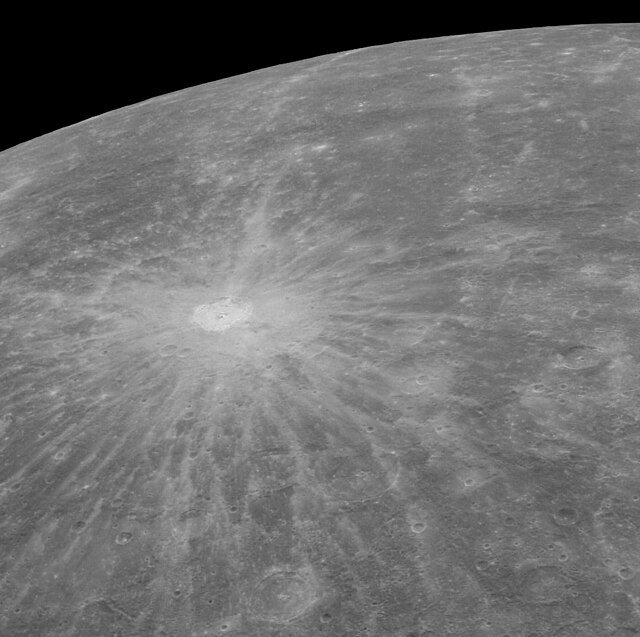In planetary geology, a ray system comprises radial streaks of fine ejecta thrown out during the formation of an impact crater, looking somewhat like many thin spokes coming from the hub of a wheel. The rays may extend for lengths up to several times the diameter of their originating crater, and are often accompanied by small secondary craters formed by larger chunks of ejecta. Ray systems have been identified on the Moon, Earth, Mercury, and some moons of the outer planets. Originally it was thought that they existed only on planets or moons lacking an atmosphere, but more recently they have been identified on Mars in infrared images taken from orbit by 2001 Mars Odyssey's thermal imager.
Fresh impact crater on Mars showing a prominent ray system of ejecta. This 30 m (98 ft) diameter crater formed between July 2010 and May 2012 (19 November 2013; 3°42′N 53°24′E / 3.7°N 53.4°E / 3.7; 53.4).
Gratteri crater, a rayed crater on Mars that was imaged by THEMIS at night. Image covers an area 32 km across.
The rays of Kuiper, one of the freshest craters on Mercury
Asymmetrical ray system about the lunar crater Proclus (Apollo 15 image)
An impact crater is a depression in the surface of a solid astronomical body formed by the hypervelocity impact of a smaller object. In contrast to volcanic craters, which result from explosion or internal collapse, impact craters typically have raised rims and floors that are lower in elevation than the surrounding terrain. Impact craters are typically circular, though they can be elliptical in shape or even irregular due to events such as landslides. Impact craters range in size from microscopic craters seen on lunar rocks returned by the Apollo Program to simple bowl-shaped depressions and vast, complex, multi-ringed impact basins. Meteor Crater is a well-known example of a small impact crater on Earth.
500-kilometre-wide (310 mi) crater Engelier on Saturn's moon Iapetus
Recently formed (between July 2010 and May 2012) impact crater on Mars showing a pristine ray system of ejecta
50,000-year-old Meteor Crater east of Flagstaff, Arizona, U.S. on Earth
Eugene Shoemaker, pioneer impact crater researcher, here at a crystallographic microscope used to examine meteorites







